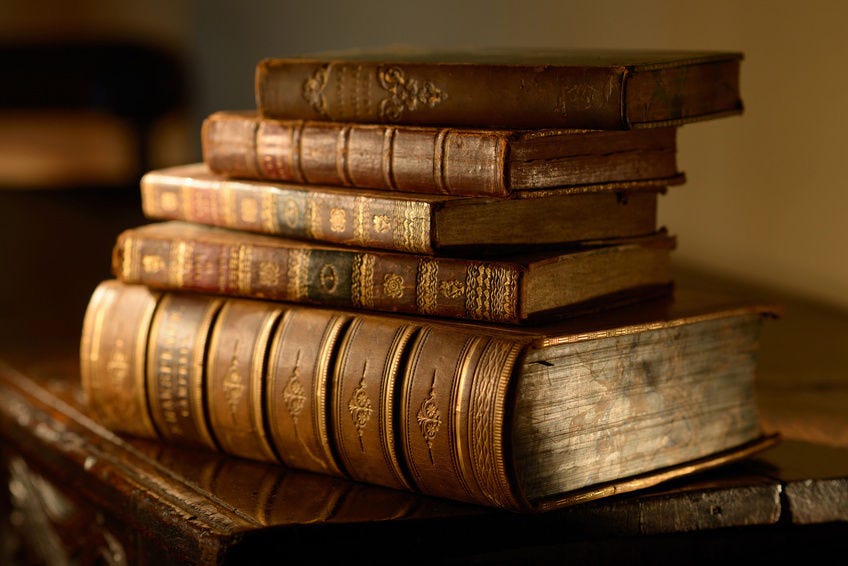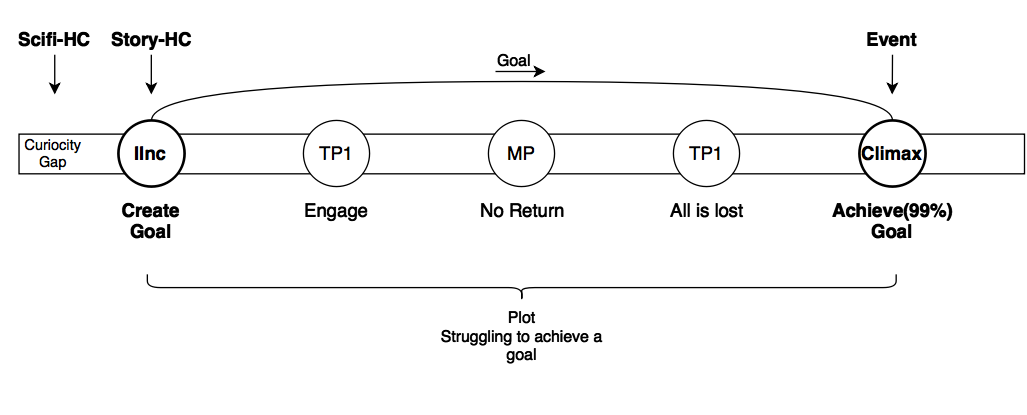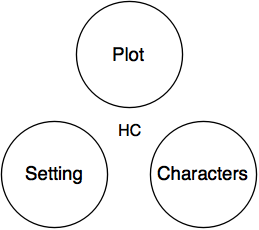What Is Happening in This Book Main Character Lesson Clip Art
Fundamentals of Story Structure
(a summary of everything I have learned during the first 3 years of learning to write fiction)

A story is made out of a series of events. The sequence of all the events is called a Plot.

An Event is a meaningful modify in the graphic symbol's life, the thing that happens during the story that transforms the world from one state into another.
During the story, the main character (protagonist) goes through a serial of events, each of them taking him closer to, or farther abroad from his Goal.
This series of events culminates in a Climax — the major, most of import event of a story, the moment when the protagonist achieves his goal (or, sometimes, fails to achieve it).
The climax is what the story is about:
- Frodo drops the band into the Mount Doom
- Luke destroys the Decease Star
- Neo defeats the Agent Smith
A story is divided into iii Acts.
The first deed is about the protagonist'south regular life beingness disrupted by some result. This outcome is called Inciting Incident (I'll refer to it every bit IInc).
IInc is the main reason the story has happened, the thing that kicks off the serial of events that lead to climax.
IInc gives the protagonist a claiming, creates a Goal — the thing the hero will exist trying to attain for the balance of the story. Often, IInc is the result of a problem created past the adversary.
- Gandalf gives Frodo the Ring he will have to drib into Mount Doom.
- Luke hears the message from Princess Leia about the blueprints he must employ to destroy the Death Star.
- Neo meets Morpheus who volition tell him about the Matrix, which he volition have to destroy to liberate humanity.
The starting time act culminates in the First Turning Betoken (TP1).
TP1 is the moment when the hero decides to get on an adventure, makes a conscious decision to appoint with the story, and begins pursuing his goal.
- Frodo leaves the Shire
- Luke's parents are killed
- Neo takes the reddish pill
The 2nd act is about a series of escalating events (successes and failures) which happen as the protagonist struggles to attain his goal.
The hero pursues his goal, and overcomes the obstacles set by the antagonist. From his victories and mistakes he learns lessons almost the earth, and gains powers.
As the hero moves further, the stakes rise, his delivery to the goal increases, he has to apply more effort and take bigger and bigger risks to move forward.
In the middle of the second human activity, the protagonist goes through the Mid Point (MP) — the signal of no return. He swims by the middle of the river, and now turning dorsum would be more difficult than reaching the other shore.
The stakes proceed to rising, until the protagonist has to take chances everything in his biggest attempt to win. He engages in the final battle against the antagonist, and puts everything on the line.
The second deed culminates in the Second Turning Betoken (TP2) — the moment when the hero'south biggest attempt fails, when all is lost, the goal is no longer accessible, the antagonist seems to win, and the protagonist has been defeated.
The third human action is about the concluding battle and its outcome.
Defeated, half-dead hero learns his biggest lesson from his worst failure.
This is usually when the biggest twist happens. The hero sees the truth. Comes up with a brilliant creative solution, understands his mistake, realizes who was the murderer all along, finds the ultimate weapon, etc. This is what will enable him to turn his defeat into a victory.
- Harry holds a basilisk fang
- Neo sees the Matrix code
Armed with this knowledge he gathers all of his forcefulness, and takes the final endeavor to plough things effectually, to win the battle.
The hero defeats the antagonist and finally achieves his goal.
Story Essence
What is a story? Why is it told? What lies at its core?
When the world undergoes change from one land to another, this process is called an "Event".
The point of storytelling is to relay the experience of an consequence. People listen to stories to feel an exciting and meaningful outcome, empathise it'due south reasons, and learn from it.
Story is a description of an Effect (alter of value) and the underlying reasons for that change.
Climax
A story consists of a series of smaller events, leading up to and culminating at Climax — the large and of import upshot, the reason for telling a story. The Climax is the moment such Upshot happens.
The Climax is the central to the story.
When you are writing a story, climax is the biggest affair you are looking for, and the nearly challenging thing to figure out. Once you know the climax — y'all have your story, considering all of the key story elements are continued to it.
Protagonist
We experience the story through the eyes of the protagonist, he is our avatar into the story world.
The Climax is a direct result of a deliberate activeness past the protagonist. The protagonist is a person who has a goal, and has fabricated a choice to pursue it. The Climax is the moment when the protagonist achieves (or fails to reach) his goal.
As the hero struggles to pursue his goal, he gains feel. He understands the manner the world works and the reasons for that. He learns lessons, and we learn these lessons through him.
Controlling Idea
Decision-making Thought (CI) is the underlying reason for the modify that happens, the underlying nature of the world we are trying to explain through our story. It is the answer to why the upshot has happened.
CI is an abstract idea, which is being expressed through physical events and actions.
To put information technology simply — it is a "moral", a philosophy that is being expressed. For example, children's fables are simple metaphors for expressing simple ideas ("lying is bad", "be dainty", etc).
CI is a "lesson" that the protagonist learns well-nigh the nature of the globe that enables him to attain his goal.
Usually, CI is expressed every bit a flaw that prevents the protagonist from achieving his goal, it is a "lesson" he learns during the story.
Relationships between the story elements
When you are writing a story, the climax is the cardinal element you are looking for. When you know the climax — you accept a story, and until you know it — y'all don't.
All the other elements of a story are connected to the climax, they add upward to information technology, and are defined in relation to it. If you know the climax — you know all of the crucial elements. Here's how elements relate to climax and to each other:

- Climax is a moment where the story'due south chief Event happens, that makes it the most crucial scene. Story is written about the Consequence, thus Story = Event = Climax.
- Climax is the moment when the protagonist achieves his Goal. That means that if you lot know the climax — you lot know the protagonist's goal, and vice versa. Climax = Goal.
- Inciting Incident (IInc) is, by definition, the moment when the character acquires his goal. Usually, it is a problem created past the antagonist, a problem which the hero will struggle to solve during the whole story, and will finally solve by defeating the antagonist at the climax. That means that if you know IInc = you lot know the goal, and you know the goal = y'all know the climax.
And when yous know IInc, goal, and a climax — it is easy to effigy out everything else:
- At Turning Indicate one (TP1), the hero makes a decision to pursue the goal he caused at IInc and starts on his journey.
- At MidPoint, the hero realizes he can't turn dorsum, he has a better chance of achieving his goal than going back to the way things were before.
- And at TP2, the hero seems to fail and lose his goal, it is but the reverse of what happens at climax.
Now the antagonist is a character whose role is to forbid the hero from achieving his goal by throwing obstacles on his way.
Character's friend/sidekick is a character whose function is to help the hero to achieve his goal (and to be a source of information — talk to the hero to provide exposition, explain to us what's going on, render his thoughts, etc.)
Love interest is an actress motivation for a hero to reach his goal, a source of actress complications/conflict, and a reward he gets for winning.
The hero'due south Flaw is a mistake he makes, an internal quality that prevents him from achieving his goal, and creates internal conflict.
The Controlling Idea (the "moral" of a story) is a lesson the hero learns by overcoming his internal flaw, the lesson that enables him to defeat the antagonist and achieve his goal.
That way, as you lot can see, all elements are continued through the goal to the story's climax. Any can be discovered if you lot know the climax, and when you know only some of the elements but not all — you can discover climax by following these connections.
Story Writing Process
At present that I've talked most story structure, story essence, and connexion between climax and other story elements — I will talk about the story writing process.
Story elements
There are iv crucial elements you need to know about your story:

- Setting — the globe of a story.
- Characters — protagonist, adversary, others.
- Event — the climax, the result the story is about.
- Controlling Idea (CI) — the "moral" of a story, the abstract philosophy you want to express by giving people the concrete feel of the story.
Together they form a High Concept (HC) — the principal story idea, original and interesting concept you can express in a few words.
When you know what these elements are — yous can find the key structural points (IInc, TP1, MP, TP2, Climax) of a story, and develop a Plot.
That will requite yous a pretty clear and straightforward thought of what your 3 Acts are almost. One time you know that — you can break the acts into scenes , and create Outline. And so use that outline(listing of scenes) to simply expand it into writing.
Process
Yous find these elements by asking and answering questions. In practice whatsoever of the elements can be an initial thought/inspiration, the process is chaotic, it involves jumping back and forth between questions, tweaking, randomness, serendipity, imagination, etc. The following is an idealized, orderly version of a process.
Grapheme in a state of affairs
Information technology makes sense to begin by finding an interesting setting, and one time you know where your story takes place information technology is easier to find an interesting character.
I too call it "SciFi Premise", because SciFi/Fantasy tend to revolve around worldbuilding and unusual characters in interesting situations.
Problem
Once you know the setting and characters, your biggest goal is to find your climax.
It is difficult to come with the climax on its own, but as I've said, all the elements in the story are continued, and yous can unravel all of them past starting with ane.
In my feel, the easiest one to brainstorm with is IInc, or, in other words, a problem.
Because once you have your graphic symbol in a setting, y'all can reply the question "What can go wrong?"
Ordinarily this problem is caused past the antagonist, so if you can figure out who that is information technology may help you to find the problem.
Goal
In one case you have your problem — you'll have your IInc, you know where your story has started.
And, y'all'll immediately know that the character's goal is to solve this problem.
So even if you don't have a very thought of your climax — you lot know that your grapheme will solve this problem at climax.
TP1, MP, TP2
Then y'all can effigy out TP1 — it is merely the point when the hero decides to pursue his goal.
In one case you know that, y'all tin imagine what difficulties may ascend, and how things can escalate, and every bit they escalate more and more — you know your MP, and every bit they escalate even further — you can figure out the big final effort at achieving his goal, and how information technology tin can go horribly wrong and fail.
Climax
Finally, in one case you know the TP2 — the everyman point for the grapheme — you lot tin can figure out how he volition turn things around and solve everything at climax.
Steps
Here's a convenient list of questions to summarize it:
- Setting. What is the world of my story?
- Characters. Who are the characters?
- Trouble (and Goal). What can get wrong? What problem will my character need to solve?
- Appoint. How does the character brainstorm pursuing his goal?
- Escalate. How tin can the trouble get more than difficult? What obstacles will the hero face?
- Lose. What is his terminal, most difficult, highest-stakes claiming, and how tin it fail?
- Turn How can the hero plow his defeat into a victory? How does he solve the trouble?
Explore
Once you know the things y'all are looking for, the main steps you lot need to accept — y'all search for them by asking questions, thinking, writing.
Usually it is difficult to write the story completely top-down (start from outline, detect key points, and break things down until you have individual scenes), and it is hard to do it bottom-up (just sitting down, writing, and going wherever it takes y'all). So I think that the all-time mode is to combine both options and jump back and along. You think well-nigh the outline, yous inquire questions, you sit down to write, and then go dorsum to correcting the outline.
If yous detect yourself unable to reply some of the questions, I suggest writing a list of five possible options, not the best ones, just something that could barely fit, and then pick the i y'all like the about.
Another useful idea at this point is to just ready yourself a goal to write a certain number of words (250 or 500 works well). When you are doing that, you lot should not remember about the outline, or the story structure, or theory — just type words, this procedure will aid you to observe the answers and new ideas.
Resources
To go deeper into this subject and learn more than, I highly recommend the book Story by Robert McKee, this incredible lecture on screenwriting by Michael Hauge, a serial of lectures by Brandon Sanderson, and my class nigh creating adventures
Source: https://writingcooperative.com/fundamentals-of-story-structure-e199f131a891
0 Response to "What Is Happening in This Book Main Character Lesson Clip Art"
Enregistrer un commentaire